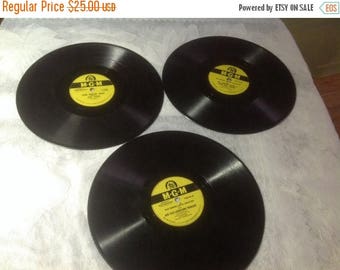

Click Ok (These settings will stay the same so if you do a bunch in a row you just have to click OK).(However this initial setting does not matter because it will just keep recording even if longer than 10 minutes)ģ. Initial length (10:00) I have never seen a 78rpm record last more than 10 minutes even when recorded at 33 rpm. Click on the new button- Set the number of channels to (2 stereo) My records are mostly from the 1910's thru the 1930's and 70 % recording volume works fine for most but again some have to be recorded at different volume levels.ġ. Some of the very early ones 1900-1910 era may have to be recorded at 100 % volume. (I have many of these).įirst i set the record volume at 70 % but with 78's this can vary greatly - most of the later 78's(those recorded in the 1950's should probably be recorded around 40 %). You can also record slightly warped 78's that no longer can be played at 78rpm, BUT may still be playable at lower speeds. The reasons for recording 78's at lower speeds is because most of the modern record players do not have the 78 speed on them.
33 1 2 rpm records trial#
The following I have learned mostly through trial and error. After I record them and save them to the internet archives and CD's, I give them away. Well I am glad i kept all of them now, because even if they just have one more play left (no matter how bad it is)-Goldwave can usually rescue it. A lot of them should have been thrown away many years ago.but you know how it is when you collect stuff-somehow you just can't let go. I purchased Goldwave because I have many (5000-6000) 78 rpm records and plan to buy more if I find them at the right prices. Excessive heat can warp records which leads to fluctuating pitch in your music as the stylus travels up and down with the bent record.Hello, First of all I am a registered user for about 2 months and I love this software.

Use the guides on this page to clean your records. Records are vulnerable to scratches and dust, which are picked up by the stylus as noise and popping. 45s were commonly used in jukeboxes and were sometimes used when an artist wanted to make a shorter mini-album. Some singles and two/three song discs (called EPs or “extend play discs“) were released on 7-inch vinyls played at 45 rpm. Given these advances in record technology, the discs were given the new name LP record, which stands for “long play record.” In contrast, LP records can hold about 23 minutes of music per side due to their tightly-spaced microgrooves and rotational speed of 33 and a third rpm. Since the grooves on these so-called 78s are widely spaced, a record holds only five minutes of music per side. Turntables for these earlier records spin the disks at 78 rotations per minute (rpm).

33 1 2 rpm records full#
Grooves are pressed onto both sides of the disc, so listening to a full album requires flipping the disc.īefore vinyl LP records, music discs were made from shellac, a hard resin produced by lac bugs. People often refer to LP records as vinyls because PVC stands for “poly vinyl chloride.” Any vinyl disc works by encoding music as a long spiral groove in its surface a record player sets a stylus in this groove and uses the back-and-forth motion of the stylus as the disc spins to ascertain the encoded audio. LP records are produced as 10 or 12-inch diameter discs made from PVC-the same material as pipes in a building. The LP record is an analog sound recording format used primarily from the 1950s to the 1980s.


 0 kommentar(er)
0 kommentar(er)
